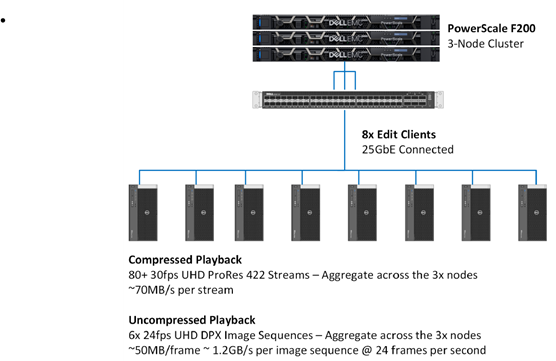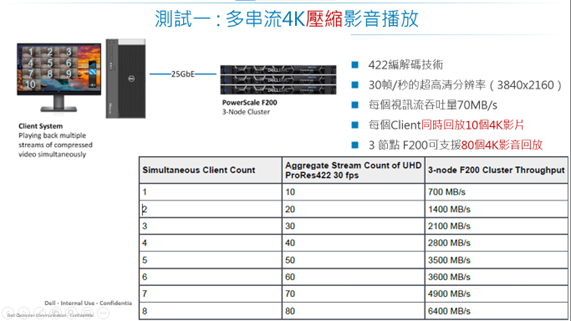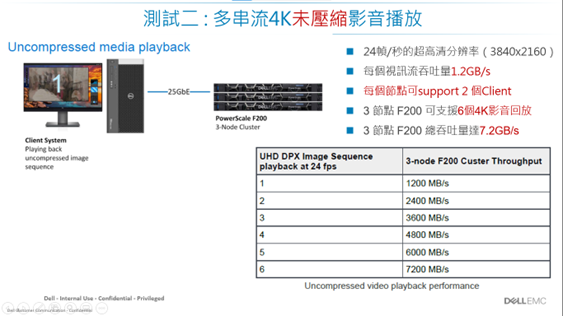Compressed and uncompressed video performance estimates of the PowerScale F200 three-node cluster in 4K video editing by Dell Technologies
In June 2020, Dell announced the Gen6.5 PowerScale model of the Isilon Scale-Out NAS and further changed the product brand name to PowerScale. Dell’s naming policy was also adopted for the Power family, such as PowerStore, PowerMax, and PowerFlex.
At the same time, Dell also announced two brand-new models: the PowerScale F200 and the PowerScale F600. They come in a 1U PowerEdge R640 chassis and are powered by OneFS 9.0 to deliver the same software functions as Isilon and are equipped with SAS SSDs and all-flash NVMe SSDs, 25-100GHz high-speed network bandwidth, a maximum of 15.80 million IOPS, and a system throughput of 945 GB/s.
Here are the compressed and uncompressed video performance estimates of the PowerScale F200 three-node cluster in 4K video editing by Dell Technologies.
Let’s discover the performance of the all-flash Scale-Out NAS Powerscale F200 with a high price-performance ratio.
PowerScale is the latest generation of Dell Technologies hardware featuring the OneFS scale-out NAS file system. The Isilon F200 node type is ideal for teams that need high performance or want to add a layer of flash storage to their existing Isilon clusters.
This article lays out a sample architecture showing eight client systems playing back a variety of Ultra HD video content, both compressed and uncompressed.
With eight client systems connected to the minimum three-node F200 cluster, outstanding results were achieved. 80+ compressed ProRes 422 Ultra HD streams played in aggregate with no dropped frames. Switching to uncompressed material, 6x uncompressed DPX image sequences played back on this same three-node F200 PowerScale cluster.

On this reference architecture, video was played back from a three-node F200 PowerScale cluster (three nodes being the minimum PowerScale cluster size). The cluster’s front-end ports were connected using 25 GbE and 9000 mtu to a network switch, as were the eight editing clients. The testing of this architecture was done with Windows 10 clients connected through the SMB3 network storage protocol, 25 GbE, and 9000 mtu. OneFS Smart Connect allows for client connections to be distributed between nodes. As the eight clients were not clearly divided between the three nodes, nodes 1 and 2 had three clients connected while node 3 had two connections. No special client tuning was performed on the Windows workstations beyond verification of SMB3 multichannel.
Most media workflows deal with compressed video. There are a wide range of compressed video formats with technical or creative reasons driving the format choice.
For the purpose of this article, Apple’s ProRes™ 422 codec was used for compressed media playback. ProRes files are Ultra HD resolution (3840x2160) at 30-frames per second with a stereo audio track at 24 bits and 48khz. The total throughput of each ProRes stream in this instance worked out to approximately 70 MB/s of compressed video and audio.
Each of the client systems in the testing for this architecture could sustain 10 simultaneous streams of ProRes 422 UHD video playback. With 10x simultaneous streams, the CPU on the client systems began to reach 85% utilization. Playback of compressed media is taxing on client systems because those systems must decompress the media as it is being read off the storage in real time. Adding additional video streams further taxed the CPU of the client workstations and caused frames to drop during playback on these client systems. Thus, in this architecture, the limits of the client systems were reached before the limits of the PowerScale storage cluster were reached.

Color grading and finishing workflows typically deal with image sequence based uncompressed media formats such as DPX. These formats are less taxing on client systems since the frames do not need to be decompressed during playback (with the downside being that they take up more storage space). As such, it is possible to drive storage performance without running into client system bottlenecks.
The DPX image sequences in this architecture were Ultra HD resolution (3840x2160), 16-bit color depth at 24-frames per second. Each frame was approximately 50 MB in size which worked out to 1.2 GB/s per image sequence at this frame rate. The PowerScale F200 cluster could sustain 2x of these DPX image sequences per node or 6x image sequences across the three-node cluster.

Conclusion
PowerScale and OneFS are an ideal match for media and entertainment applications. The system allows for the creation of a single file system that can handle video editing, VFX, animation, rendering, transcoding, ingesting, and playback. PowerScale gives content creators an easy path to integrating industry-leading OneFS into their workflows.
PowerScale is the latest revision of hardware that runs the OneFS network storage operating system. As with the previous Isilon hardware, PowerScale is a node-based scale-out storage platform. A PowerScale node consists of storage, computing, and memory resources. The nodes cluster together to create a single OneFS file system.
A PowerScale cluster starts with a minimum of three nodes. PowerScale nodes can be part of a new cluster or added to existing Isilon OneFS storage clusters. Adding additional PowerScale nodes increases both the capacity and aggregate performance of the OneFS storage cluster with no downtime or manual rebalancing required.
The three nodes of the PowerScale F200 provide a throughput of 7.2 GB/s for handling various demands for high performance. It also features scale-out to 252 nodes and linear performance enhancement and delivers secure and reliable fault tolerance, making it suitable for serving as the Tier 1 performance cluster node in existing Isilon clusters.
Three nodes for 4K video playback/editing demands at 7.2 GB/s
On-demand scalability for different models
Expanding F200/F600 nodes for more editing staff
Expanding A200/A2000 nodes for more archived videos
Integrating Isilon models with the SmartPool
Automatic layering of videos required for editing to the F200 nodes and automatic layering of edited videos to the A200 node.
Other scenarios suitable for PowerScale & Isilon
#SYSAGETechnology
#SYSAGE
#PowerScale
#Isilon
#F900
#Big Data Analysis
#Hadoop
#AI
#AI/ML/DL
#4K/8K
#Unstructured
#Scale-Out NAS
Reference:http://https://www.sysage.com.tw/news/technology/189